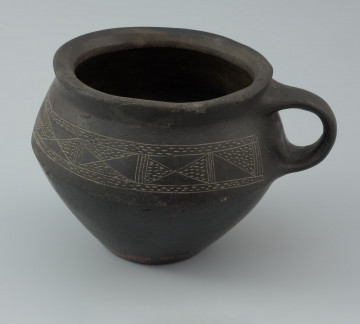
Decorated mug
National Museum in Szczecin
Part of the collection: Antiquity
An iron sword with a double-edged blade, dating back to the 2nd - 1st centuries BC, was found in a cremation burial in Oleszno, Drawsko poviat. Before being placed in the grave, the sword was ritually rolled four times to form a spiral. The ceremonial destruction of weapons was a common practice among the people inhabiting the Oder and Vistula basins between the 2nd century BC and the 3rd century AD. The presented weapon represents one of the four basic types of double-edged swords used in the last two centuries BC. It is classified based on the way of transition of the tang into the blade. It is believed that the more artfully crafted pieces were imported from the Celtic areas. The cremation cemetery in Oleszno where the sword comes from was discovered by accident in December 1933 during the construction of a road to Drawsko Pomorskie. It was used by the people of the Oksywie culture in the younger pre-Roman period, in the 2nd and 1st centuries BC. In cemeteries associated with that culture, the male inhumation graves were furnished with weapons, often ritually destroyed during burial rites.
Bartłomiej Rogalski
Author / creator
Dimensions
cały obiekt: height: 4 cm, width: 17 cm
Object type
furnishings and equipment; weapon; sword; double-edged sword
Technique
metallurgical; forging
Material
iron
Creation / finding place
Owner
Muzeum Narodowe w Szczecinie
Identification number
Location / status